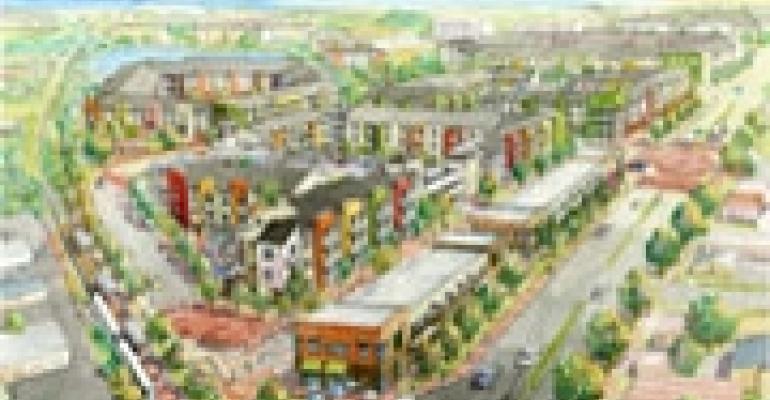
Construction has begun on the first mixed-use development designed around a commuter rail station in Austin, Texas. When all phases of the $100 million project are complete, Midtown Commons at Crestview Station will provide approximately 900 apartments and 64,000 sq. ft. of commercial space. Developer Trammell Crow Co. also has obtained approval for as many as 500 single-family homes and condominiums on an adjacent tract for future sale to homebuilders.
“Our prospect activity for the retail, office and multifamily has been very strong,” says Lance Sallis, managing director in the Austin office of Trammell Crow. “We’ve been pleasantly surprised by the number of inquiries we’ve received.” Trammell Crow is developing the first phase of Midtown Commons through its wholly owned subsidiary, High Street Residential, and its equity partner, USAA Real Estate Co.
By late February 2009, High Street plans to complete 316 luxury apartment units on the site as well as two commercial buildings that will provide a combined 30,300 sq. ft. of ground-floor retail and 30,300 sq. ft. of second-floor office space.
Phase I construction will cover 21 acres of a 73-acre project site adjacent to the future Crestview Station rail stop. The Austin area’s Capital Metropolitan Transportation Authority is developing the station and other stops along an existing freight rail line that will begin offering the metro area’s first commuter rail service this fall.
Trammell Crow, now a subsidiary of CB Richard Ellis (NYSE:CBRE), first acquired the 73 acres in partnership with Stratus Properties in 2005. Formerly a research and development facility owned by Huntsman Chemical, the land required extensive soil remediation to make way for new commercial uses with associated roads and infrastructure, Sallis says.
The land is now primed to host an urban mix of uses just two miles north of the University of Texas campus and four miles north of Austin’s central business district. Crestview Station has received a 3-star rating from Energy Star, a joint program of the U.S. Environmental Protection Agency and the U.S. Department of Energy that helps protect the environment through energy efficient products and practices. Some energy-saving project components include recycled construction materials, a central building recycling center, reuse of water for landscaping, double-pane windows, efficient cooling systems and Energy Star appliances.
Unlike conventional mixed-use infill projects, Midtown Commons will feature wide streets with plenty of maneuvering room for Capital Metro buses conveying commuters to and from trains, Sallis says. “We were also trying to have a tight, urban, dense site,” he says. “It took compromises on everyone’s part to do that.”
Capital Metro is working with Trammell Crow to connect its new station directly with Midtown Commons, according to Misty Whited, a spokesperson for the transit authority. Capital Metro is developing two more stations along the 32-mile rail line including one in Leander, a community at the northern end of the route, and is working with the City of Austin to coordinate development of the rail terminal in downtown Austin.
“We’ve always had an idea of placing our station in that [Crestview] area because it’s one of the heaviest corridors,” Whited says of the station that will open adjacent to Midtown Commons. Trammell Crow has developed other transit-oriented projects around the nation and understands the rail line’s potential to drive commercial property uses, Whited says. “They’re keyed in on transit-oriented development and they really know that can be successful.”
Transit-oriented development isn’t entirely new to Texas. The Dallas Area Rapid Transit system, or DART, links 13 cities in the Dallas/Fort Worth metropolitan area and has spawned several commercial developments. One of those, Mockingbird Station, has fueled extensive retail and apartment construction, and a stop in Plano has driven a redevelopment of that community’s downtown area, according to Brian Jetty, executive vice president of the North Texas Commercial Association of Realtors and Real Estate Professionals.
Even so, transit-oriented development is an immature field in Texas, where professionals have been slow to try mass transit. “I don’t have a sense that culturally we’re there yet,” Jetty says. “If you’re making $200,000 a year, you’re probably not taking mass transit even if it runs from right by your house to right by your office.”
In Austin, however, insufficient highway infrastructure results in commute times that are particularly long for a secondary market. That’s why transportation planners expect the planned rail service to be a hit with commuters. “Austin is booming and it’s not going to stop anytime soon,” says Whited of Capital Metro. “The downtown population is increasing every day, and we’re doing our best to provide more choices for people who live in this area.”
If developers like Trammell Crow want to help make commuter rail stops more successful by providing complementary projects, Capital Metro is ready to listen to their ideas, she says. “We’re willing to work with anybody who’s got transit-oriented development in mind.”

